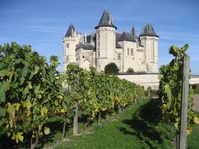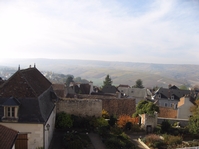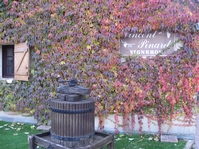The Loire Valley is one of the world’s greatest–but most under-appreciated–sources for fresh, versatile, un-fussy wines. There’s actually good news in this, since the gap between the renown of Loire wines and their true quality allows savvy wine lovers to snap up excellent wines that are priced well below their actual value. This is true for Loire whites and sparklers, but the discrepancy between performance and price is probably widest for the region’s delicious reds, which feature a light, soft profile that makes them perfect for many foods that would be overwhelmed by the big, brawny reds that remain so popular these days.
Although Loire reds have a devoted following in Paris bistros (and elsewhere among those few who know them), the fact is that Loire wines as a group aren’t as easy to know as they are to enjoy. This situation merits our attention before we turn specifically to the region’s reds, since you might otherwise wonder, “If Loire wines are so good, why haven’t I heard more about them?”
The Loire’s many sub-regions are scattered along France’s longest river, which flows north and west from its source in the Massif Central for more than 600 miles to the Atlantic. Widely dispersed in spatial terms, the Loire is no less challenging when it comes to nomenclature, as the wines break down into more than 50 appellations contrôlées.
for more than 600 miles to the Atlantic. Widely dispersed in spatial terms, the Loire is no less challenging when it comes to nomenclature, as the wines break down into more than 50 appellations contrôlées.
Of these appellations, only Muscadet, Pouilly Fumé, Sancerre and Vouvray are widely known in North America. Since their names don’t disclose the grape variety from which the wines are made, these four can’t share their fame with their neighbors. A novice who loves the taste of Sauvignon Blanc from Sancerre won’t likely know that comparably marvelous Sauvignons are also crafted in nearby in Menetou-Salon, Quincy and Reuilly.
These factors make it easier to conceive how certain Loire wines can be outstanding and little known at once. However, there are also important continuities linking Loire wines and making them surprisingly easy to understand and appreciate.
Whether sourced from a maritime climate along the Atlantic or a continental one well inland, Loire wines all show a family resemblance to one another in general terms of structure and style. Almost every grape grown in the Loire is planted near the northerly limit at which it can be ripened by the end of the growing season, and moderately ripened grapes produce moderately rich wines.
As a result, all Loire wines–whether white or red, dry or sweet–are marked by freshness and acidity rather than heaviness. Even a luscious, late harvested wine made from Chenin Blanc in Quarts-de-Chaume or Bonnezeaux will still be lithe and bright. And since Loire producers know that their wines excel by dint of freshness and purity rather than weight and power, they are among the world’s most judicious users of new oak barrels.
Like many wine writers, I regard the Loire as a stream of sanity in world that has gone mad for over-oaked, over-ripe, overly pushy wines.
The proposition that heavy, oaky wines can be impressive but nevertheless difficult to utilize enjoyably is one that can be demonstrated, and perhaps it is best demonstrated by thinking about how various styles of wines work when paired with lighter foods, especially in summertime. These go together, of course, as warm weather calls for lighter foods just as the cold of winter calls for rich dishes like stew or cassoulet. Since I’m writing this in January, you may need to employ your imagination to follow the point, though it is true that most of us also eat light foods in winter, whether the purpose is to vary our diet or shed a few post-holiday pounds.
Lighter foods are easily overwhelmed by big, assertive wines, whereas they harmonize naturally with lighter, more subtle ones. The fresh acidity of Loire whites also makes them perfect for summer sipping–just as lemonade and lemony iced tea rise in prominence along with temperatures. The summer synergy between a platter of cold, briny oysters and a chilled glass of Pouilly-Fumé is an object lesson requiring no explanation. Likewise a simply prepared filet of freshwater fish paired with a dry, mineral-tinged Savennieres signals the end of any argument about the merits of lighter wines.
However, I believe the Loire’s most conclusive case for excellence as a food partner over forceful, oaky wines lies on the red end of the spectrum. For example, you could find a nice substitute for your oysters in a Sauvignon Blanc from South Africa or New Zealand. But with a grilled cut of pork or veal, the world offers few adequate substitutes for a lightly chilled glass of Chinon.
If you do find a worthy substitute for that glass of Chinon, it will likely have been produced somewhere nearby along the 50 mile stretch of the Loire that flows between Tours and Angers. Chinon is the best-known of five appellations in this area that work predominantly with Cabernet  Franc to produce the Loire’s remarkable light reds. The others are Bourgueil, St.-Nicholas-de-Bourgueil, Anjou-Villages and Saumur-Champigny. One can also find very nice, very affordable reds labeled simply as Anjou or Touraine, but the five leading appellations are rivaled within France for high-end performance in light reds only by Burgundy, and in the wider world only by Chianti and Rioja.
Franc to produce the Loire’s remarkable light reds. The others are Bourgueil, St.-Nicholas-de-Bourgueil, Anjou-Villages and Saumur-Champigny. One can also find very nice, very affordable reds labeled simply as Anjou or Touraine, but the five leading appellations are rivaled within France for high-end performance in light reds only by Burgundy, and in the wider world only by Chianti and Rioja.
Evidence indicates that Cabernet Franc migrated into the area late in the 12th century, coming from Saint-Émilion in Bordeaux. It was a promising candidate for the northerly vineyards of the Loire since it ripens earlier than Cabernet Sauvignon, and yet it ripens late enough to take advantage of the Indian summers that extend the growing season into the autumn of great years.
It is often called Breton in the Loire, though not necessarily to distinguish it from Cabernet Sauvignon, which also plays a role in Loire viticulture. That role is limited by law in some appellations, as in Chinon, Bourgueil and St.-Nicholas-de-Bourgueil, where a ceiling of 10% is enforced. Breton may be a second-stringer in Bordeaux, but it is a star in the Loire, where the single word, “Cabernet” almost always means “Franc.”
Three other red grapes play notable roles in the Loire. Gamay, the grape of Beaujolais, makes nice quaffing wines in Anjou. Burgundy’s Pinot Noir makes lovely light reds and rosés in and around Sancerre, and Malbec is gaining importance in Touraine. Nevertheless, those new to Loire reds should start with the five leading appellations working with Cabernet Franc, which together comprise the most northerly source of excellent reds in Europe.
Before we get down to specifics, though one key thing to remember is that there’s a significant sense in which these wines aren’t as northerly-seeming as they were not long ago, as a notably warming climate has made for significantly riper wines that remain light, but now have more fruit and softer tannins that ever before. If you tried reds from the Loire in the past but were put off by their thin-ness or harsh tannins, it is time to try them again, and here’s what to do about it:
Chinon is the easiest to find in export markets, and among my favorite producers are: Philippe Alliet, Bernard Baudry, Couly-Dutheil, Domaine Crespin, Fabrice Gasnier, Château de la Grille, Charles Joguet, Domaine de Noiré and Domaine de la Perriere.
From the two Bourgueil appellations, look for Yannick Amirault, Catherine & Pierre Breton, Domaine de la Butte, Domaine de la Lande, Frederic Mabileau and Gérald Valée.
Leading Anjou-Villages producers include Château Pierre-Bise, Domaine de Montgilet and Domaine des Rochelles.
Top producers in Saumur-Champigny include Le Clos des Cordeliers, Paul & Frederik Filliatreau, Domaine du Hureau, Domaine des Roches Neuves, Antoine Sanzay, and Château de Villeneuve.
For Pinot Noir, look for Sancerre Rouge from Alphonse Mellot, Vincent Pinard, Pascal and Nicolas Reverdy, Claude Riffault, Jean-Max Roger, and Domaine Vacheron (which makes amazing wines that can last and actually improve for two decades). For Pinot from Menetou-Salon, seek out the wines of Philippe Gilbert and Domaine Henry Pelle.
Pinard, Pascal and Nicolas Reverdy, Claude Riffault, Jean-Max Roger, and Domaine Vacheron (which makes amazing wines that can last and actually improve for two decades). For Pinot from Menetou-Salon, seek out the wines of Philippe Gilbert and Domaine Henry Pelle.
Although the best of these Loire reds can benefit from a decade or more of ageing, one of their primary virtues is that they are deliciously accessible when very young. Paired with almost any moderately robust dish, they offer lots of fresh flavor in a modest profile that will flatter rather than flatten your food.
* * *
Questions or comments? Write to me at [email protected]
Read more from Michael: Michael Franz
Connect on Twitter: @Michael_Franz
